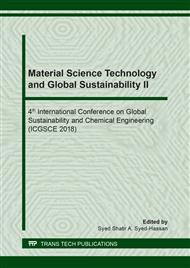[1]
Vincent, M.C., Miller, H. B., Milton-Tayler D., and Kaufman, P. B. Erosion by Proppant: A Comparison of the Erosivity of Sand and Ceramic Proppants During Slurry Injection and Flowback of Proppant. Soc. Pet. Eng., (2004), 1–17.
DOI: 10.2118/90604-ms
Google Scholar
[2]
Zu, J.B., Hutchings, I.M., and Burstein, G.T. Design of a Slurry Erosion Test Rig. Wear, 140(2), (1990). 331–344.
DOI: 10.1016/0043-1648(90)90093-p
Google Scholar
[3]
Fang, Q., Xu, H., Sidky, P.S., and Hocking, M.G. Erosion of Ceramic Materials by a Sand Water Slurry Jet. Wear, 224, (1999), 183–193.
DOI: 10.1016/s0043-1648(98)00309-3
Google Scholar
[4]
Iwai, Y., Miyajima, T., Honda, T., Matsubara, T., Kanda, K.., and Hogmark, S. Evaluation of Erosive Wear Resistance of Tin Coatings by a Slurry Jet Impact Test. Wear, 261, (2006),112–118.
DOI: 10.1016/j.wear.2005.09.030
Google Scholar
[5]
Al-bukhaiti, M. A., Ahmed, S. M., Badran, F. M. F. and Emara, K. M. Effect of Impingement Angle on Slurry Erosion Behaviour and Mechanisms of 1017 Steel and High-Chromium White Cast Iron. Wear, 262, (2007). 1187–1198.
DOI: 10.1016/j.wear.2006.11.018
Google Scholar
[6]
Faber, K. and Oweinah, H. Influence of Process Parameters on Blasting Performance with the Abrasive Jet. 10th International Symposium on Jet Cutting Technology, (1990).
Google Scholar
[7]
McLaury, B.S, J. Wang, S.A. Shirazi, J.R. Shadley, E.F. Rybicki. Solid Particle Erosion in Long Radius Elbows and Straight Pipes. Annual Technical Conference and Exhibition, San Antiono, SPE-38842-MS (1997).
DOI: 10.2118/38842-ms
Google Scholar
[8]
Ali, J. Sand Erosion Control by Using Chokes in Series in Deep, High Pressure Oil Producing Wells in North of Mongas, Venezuela. Annual Technical Conference and Exhibition, San Antiono, SPE-38843-MS (1997).
DOI: 10.2118/38843-ms
Google Scholar
[9]
Salik, J. and Buckley, D. Effect of Erodent Particle Shape and Various Heat Treatments on Erosion Resistance of Plain Carbon Steel, NASA Technical Paper 1755, (1981).
Google Scholar
[10]
Kaufman, P. B., Anderson, R. W., Parker, M. A., Brannon, H. D., Neves, A. R., Abney, K. L., Penny, G. S. Introducing New API/ISO Procedures for Proppant Testing, SPE-110697, 7 (2007).
DOI: 10.2118/110697-ms
Google Scholar
[11]
ISO 13503-2: 2006. Petroleum and Natural Gas Industries-Completion Fluids and Materials-Part 2: Procedure for Measuring Properties of Prop Pants Used in Hydraulic Fracturing and Gravel Packing Operations. ISO Draft Document, International Organization for Standardization, Geneva, Switzerland, (2006).
DOI: 10.3403/30080576u
Google Scholar
[12]
StimLab. Measurement of Properties of Proppants Used in Hydraulic Fracturing and Gravel-packing Operations. ANSI/API Recommended Practice 19C (2008).
DOI: 10.3403/30080576
Google Scholar
[13]
Levy, A. V, and Chik, P. The Effects of Erodent Composition and Shape on the Erosion of Steel. Wear, 89(2), (1983), 151–162.
DOI: 10.1016/0043-1648(83)90240-5
Google Scholar
[14]
Nguyen, V.B., Nguyen, Q.B., Zhang, Y.W., Lim, C.Y.H. and Khoo, B.C. Effect of Particle Size on Erosion Characteristics. Wear, 348-349, (2016), 126–137.
DOI: 10.1016/j.wear.2015.12.003
Google Scholar
[15]
Bharat, S.C., Siddhartha and Ananat, K. P. Erosion Wear of Ductile Materials: A Review, in International Conference on Advancements and Recent Innovations in Mechanical, Production and Industrial Engineering (ARIMPIE - 2016), (2016), 17-22.
Google Scholar
[16]
Laguna-Camacho, J. R., Vite-Torres, M., Gallardo-Hernández, E. A., and Vera-Cárdenas, E. E. Solid Particle Erosion on Different Metallic Materials. In Tribology in Engineering, Pihtili H. (Ed.) (2013).
DOI: 10.5772/51176
Google Scholar
[17]
Macchini, R., Bradley, M.S.A. and Deng, T. Influence of Particle Size, Density, Particle Concentration on Bend Erosive Wear in Pneumatic Conveyors. Wear, 303, (2013), 21–29.
DOI: 10.1016/j.wear.2013.02.014
Google Scholar
[18]
Abu Bakar, N.F., Anzai, R. and Horio, M. Microscopic Evaluation of Binderless Granulation in a Pressure Swing Granulation Fluidized Bed. Chemical Engineering Science, 98, (2013), 51–58.
DOI: 10.1016/j.ces.2013.04.048
Google Scholar
[19]
Camacho J., Lewis R. and Dwyer-Joyce R. S. Solid Particle Erosion Caused by Rice Grains. Wear, 267, (2009), 223-232.
DOI: 10.1016/j.wear.2008.12.034
Google Scholar
[20]
Laguna-Camacho J. R., Cruz-Mendoza L. A., Anzelmetti-Zaragoza J. C., Marquina-Chávez A., Vite-Torres M. and Martínez-Trinidad J. Solid Particle Erosion on Coatings Employed to Protect Die Casting Molds. Progress in Organic Coatings, 74, (2012), 750-757.
DOI: 10.1016/j.porgcoat.2011.09.022
Google Scholar
[21]
Malik, J., Toor, I., Ahmed, W., Gasem, Z., Habib, M. A., Ben-Mansour, R., and Badr, H. Evaluating the Effect of Hardness on Erosion Characteristics of Aluminum and Steels. Journal of Materials Engineering and Performance, 23, (2014), 2274–2282.
DOI: 10.1007/s11665-014-1004-x
Google Scholar


